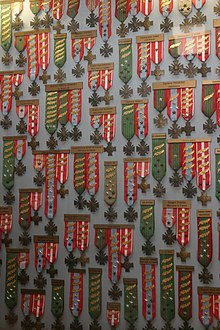Military awards and decorations
This article has multiple issues. Please help improve it or discuss these issues on the talk page. (Learn how and when to remove these template messages)
|

A military decoration is an award, usually a medal of some sort that consists of a ribbon and medallion given to an individual as a distinctively designed mark of honor denoting heroism, or meritorious or outstanding service or achievement.[1] While the United States Government does not consider all its military awards and medals as being "decorations", other countries tend to refer to all their military awards and medals as "decorations".
Civil decorations awarded to military personnel should not be considered military decorations, although some orders of chivalry have civil and military divisions. Decorations received by police and fire brigade personnel may sometimes be considered alongside military decorations, on which they may be modelled, although they are strictly not military awards.
History
Decorations have been known since ancient times. The Egyptian Old Kingdom had the Order of the Golden Collar while the New Kingdom awarded the Order of the Golden fly.[2] Celts and Romans wore a torc or received other military decorations such as the hasta pura, a spear without a tip. Dayaks wore and still wear tattoos, etc. Necklaces and bracelets were given during the early Middle Ages, evolving into richly jewelled big necklaces, often with a pendant (commonly a medal) attached.
One of the oldest military decorations still in use is Poland's War Order of [Militari] (Latin for "For Military Valour"). It was first awarded in 1792.[citation needed]
Forgery
Medals have been forged by many people to make the medal appear more valuable or to make one look like a more decorated soldier. Medal forgeries can include: Adding bars, engraving a famous soldiers name on it or creating a whole new medal. Medal forgery is illegal in most countries and can be punishable by jail time.
Contemporary use

Today military decorations include:
- Orders of Chivalry;
- Bravery awards, in the form of a cross, star or medal on a ribbon;
- Distinguished service awards, in the form of a cross, star or medal on a ribbon;
- Campaign medals worn on a ribbon;
- Service medals worn on a ribbon;
- Awards for entire units.
In most NATO militaries, only the service ribbons are normally worn on everyday occasions (as opposed to the actual medals).
See also
- List of military decorations
- List of highest military decorations
- Civil decoration
- State decoration
- Order (decoration)
- Neck order
- Commonwealth Realms orders and decorations
- Awards and decorations of the United States military
- Awards and decorations of the Russian Federation
- Awards and decorations of the Soviet Union
- Israeli Military decorations
- Awards and decorations of the German Armed Forces
- Orders, decorations, and medals of the United Kingdom
References
- ^ DoD Manual 1348.33, 2010, Vol. 3
- ^ David, Rosalie (1998). The Ancient Egyptians: Beliefs and Practices. Sussex Academic Press. p. 101. ISBN 1898723729.
